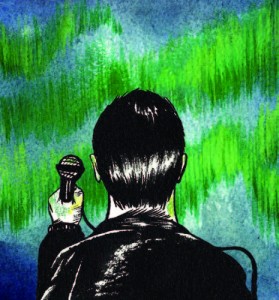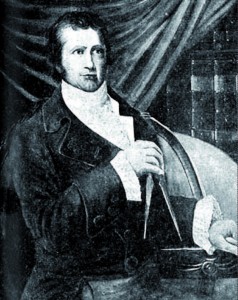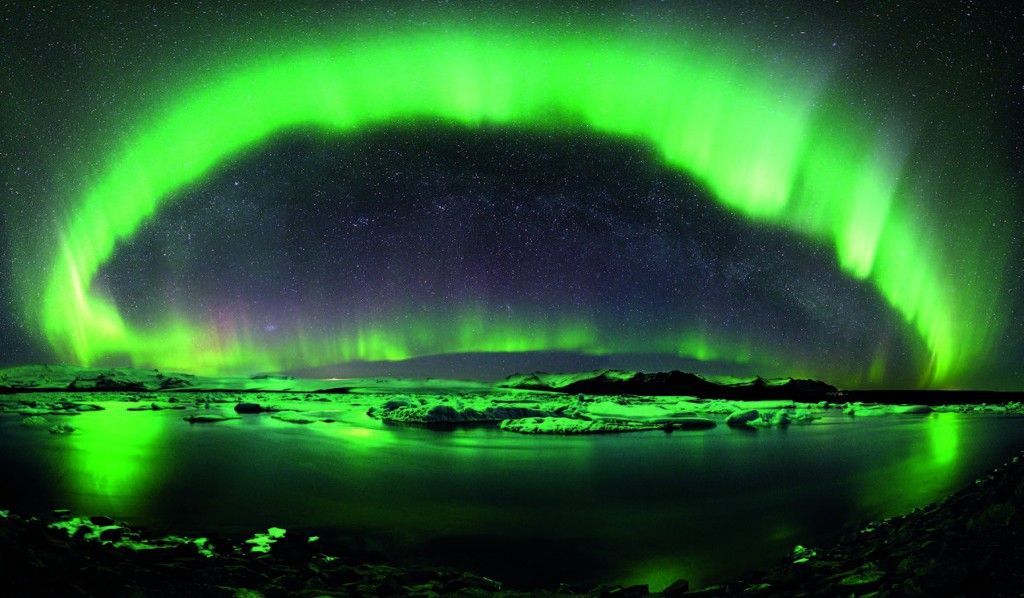WEDNESDAY, 15 MAY 2013
The aurora borealis or the Northern Lights, is a natural luminous phenomenon that occurs in the night sky at polar latitudes and is sometimes visible in the northern hemisphere. For centuries, aurora-watchers have reported hearing strange sounds of hissing and flapping during an auroral manifestation, but most scientists think of these as an anomaly.Before the emergence of geomagnetic theories, natural philosophers and scientists had various interpretations of aurorae: they thought they were caused by solar rays, sulphurous vapours, electric fluid, combustion of inflammable air, or glaciers. Indigenous people of the North, on the other hand, interpreted them as the torches of the spirits of the recently deceased, its motions as spirits (or children who died still-born) playing football, and its sounds as voices coming from the other world.
During the Enlightenment, natural philosophers sought to separate science from superstition, by establishing stricter boundaries between empirical expertise—the western savant—and folk beliefs, including those of indigenous inhabitants; although this process of ‘purification’ was unable to fully consign folk beliefs to the scrapheap. For instance, in the 1780s, while looking back at the famous appearance of the aurora in England of 1716, Thomas Pennant criticised the “vulgar” suppositions of the populace, and suggested instead the natural explanation of “a great abundance of electrical matter”. Pennant believed this theory was supported by the sounds the aurora was reported to make: “crackle, sparkle, hiss”.
However, while indigenous witnesses reported distinct sounds of rushing, hissing, rustling, and crackling during meteoritic auroral activity to western travellers—the Sami people call the aurora ‘guovssahas’ (the light that can be heard)—this became a contentious issue once the great age of Arctic exploration began in the 19th century. Even if descriptions of these sounds were remarkably similar across regions and cultures, there was no instrumental evidence of their existence, and therefore most British scientists and Arctic explorers did not believe it. Long and attentive observation by expeditioners during successive winters, utilising the latest scientific instruments, all failed to prove the existence of auroral sounds. This fact meant that perceiving the aurora borealis became interrelated with issues of credibility and expertise.
One sceptic put forward the popular argument that as none of the most well-known Arctic explorers had ever heard the aurora borealis, it was likely that any sound “might easily be attributed to the aurora, when the mind is excited by the wondrous spectacle, and susceptible to every illusion”. Naturalistic explanations ranging from acoustic illusions to environmental noise (the sound of the wind, waves, and cracking ice) were deployed if sounds occurred.
However, narratives in the library of the Scott Polar Research Institute reveal a more complicated and indeterminate picture of beliefs at the time, showing that the typical disenchanted pose of the scientific traveller was affected by testimonies from permanent European residents in the Arctic regarding the sounds of the Northern Lights. Indeed, tales received from fur traders working for the Hudson’s Bay Company could destabilise the sceptical position on auroral audibility.
Writing of his travels through northern Canada from 1769-72, the fur trader Samuel Hearne affirmed that “in still nights I have frequently heard [the Northern Lights] make a rustling and crackling noise, like the waving of a large flag in a fresh gale of wind”. Hearne’s account, which accepted that many non-indigenous travellers had not heard such sounds, became wellknown among later British explorers, but it did not have an adequate scientific theory to explain them. A scientific amateur, the English fur trader and explorer David Thompson was the first to specifically test for auroral sounds. He spent the winter of 1796-97 at Reindeer Lake, Saskatchewan, where he performed some basic experiments on the perception of the Northern Lights: “in the rapid motions of the Aurora we were all perswaded [sic] we heard them, reason told me I did not, but it was cool reason against sense. My men were positive they did hear the rapid motions of the Aurora, this was the eye deceiving the ear; I had my men blindfolded by turns, and then enquired of them, if they heard the rapid motions of the Aurora. They soon became sensible they did not, and yet so powerful was the Illusion of the eye on the ear, that they still believed they heard the Aurora. What is the cause that this place seems to be in the centre of the most vivid brightness and extension of the Aurora: from whence this immense extent of electric fluid, how is it formed, whither does it go. Questions without an answer.”
With the onset of the heroic age of British Arctic exploration in 1818, the Admiralty made it a high priority to provide answers to these questions. The scientific members of John Franklin’s Arctic land expedition of 1819-22, however, could not “distinguish its rustling noise, of which, however, such strong testimony has been given to us, that no doubt can remain of the fact”. On occasions, they came tantalisingly close to this perception: “we imagined, more than once, that we heard a rustling noise like that of autumnal leaves stirred by the wind; but after two hours of attentive listening, we were not entirely convinced of the fact”. Unable to hear them, they did receive testimony of auroral sounds from a credible source. At Fort Chipewyan in 1821, a fur trader from the North West Company told them of an aurora so powerful that “the Canadians fell on their faces and began praying and crying, fearing they should be killed; he himself threw away his gun and knife that they might not attract the flashes, for they were within two feet of the earth [...] and made a rustling noise, like the waving of a flag in a strong breeze”.
In most scientific accounts of aurorae in the 19th century there was a distinct tension between describing the wondrous spectacle of the Northern Lights while disciplining the emotions and avoiding superstition. Whereas British expeditioners could not hear the Northern Lights, they continued to collect strange stories from sources they generally trusted. For example, even a prominent sceptic like Captain George Lyon could describe the “air of magic” during one stormy night in the Arctic and write how he had “never contemplated the aurora without experiencing the most awful sensations, and can readily excuse the poor untutored Indians for supposing that in the restless motions of the Northern Lights, they beheld the spirits of their fathers roaming in freedom through the land of souls”.
Given that scientific experts continued to profess profound uncertainties about the nature of aurorae up to the 1940s, why did testimony on auroral audibility not force a change in approach? Partly, this was due to the wider disciplining of the heavens that was associated with the rise of meteorology and the decline of folk weather knowledge and prognostication during the Enlightenment. But, it was also because most reports came from permanent inhabitants of Arctic Canada: fur traders and indigenous inhabitants. Thinking about the Northern Lights, therefore, has historically involved assessing who is best qualified to observe them. This continues to play out nowadays in conversations between seasoned field scientists and aurora watchers who all know of someone who heard the Northern Lights.
Yet, recent data from Finland has reignited the debate on whether the Northern Lights can make sounds. In 2012, researchers from Aalto University recorded a series of cracking or whipping noises during an auroral manifestation. These, they claimed, were formed about 70 metres above ground level (rather than in the atmosphere) and were caused in some way by the geomagnetic disturbances associated with the aurora borealis. The researchers noted that auroral audibility was a rare phenomenon and that “details about how the auroral sounds are created are still a mystery”.
As 2013 heralds a period of solar maximum, it behoves travellers and scientists in the Arctic to remember what the fur traders said and continue to keep their ears, as well as their eyes, open.
Shane McCorristine is a Marie Curie/Irish Research Council Postdoctoral Fellow at NUI Maynooth and the Scott Polar Research Institute



